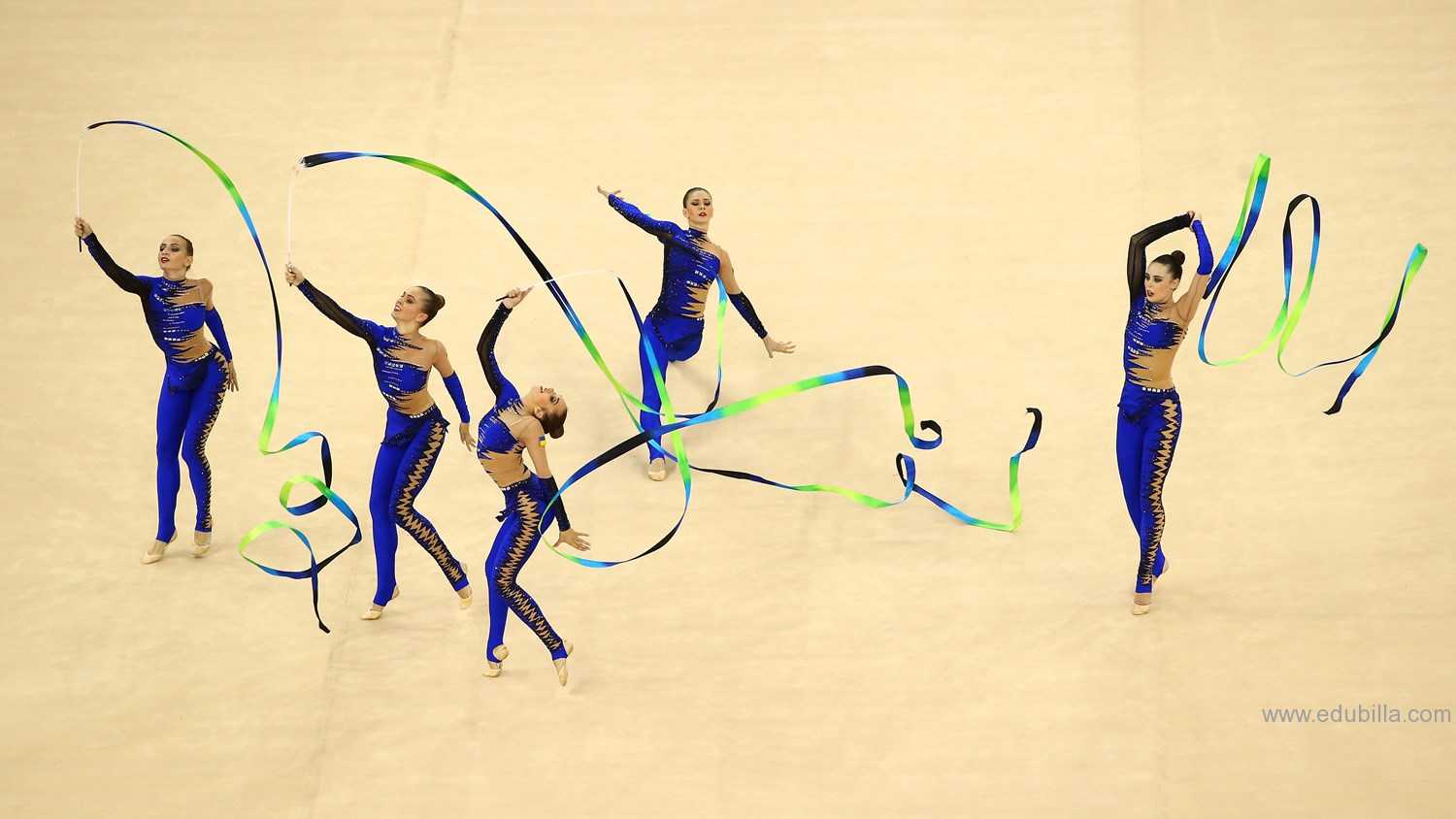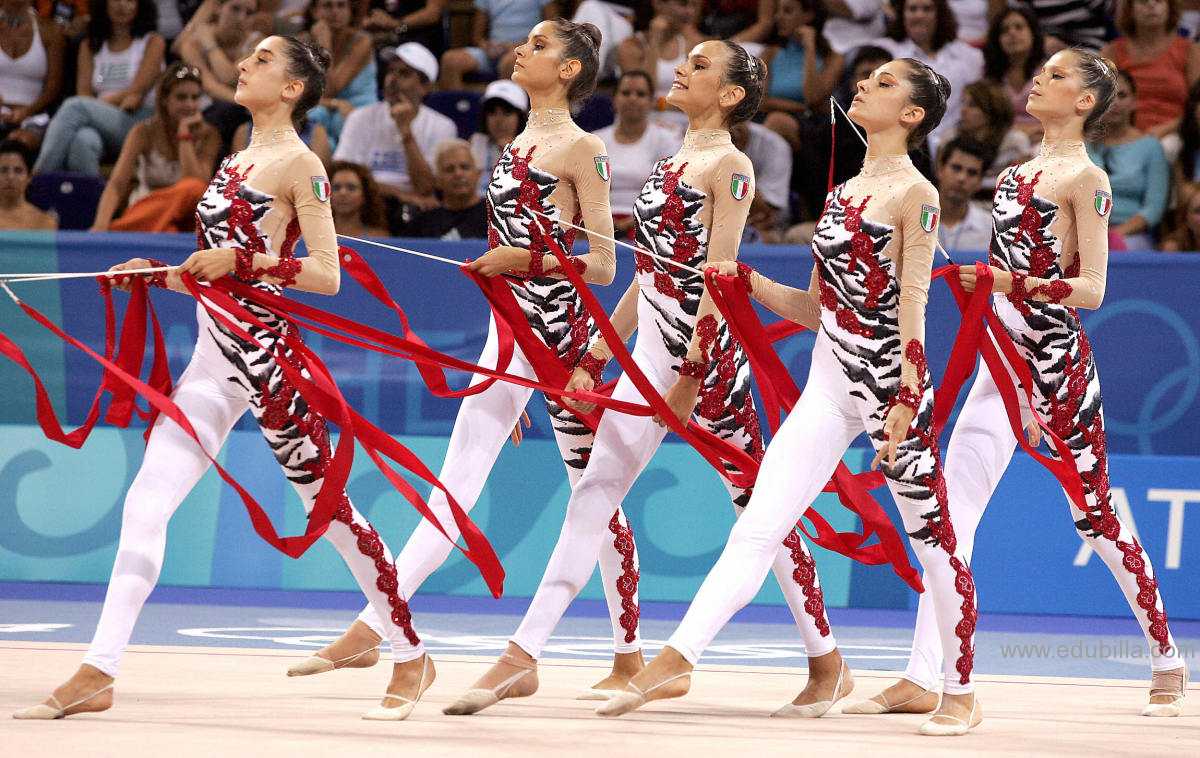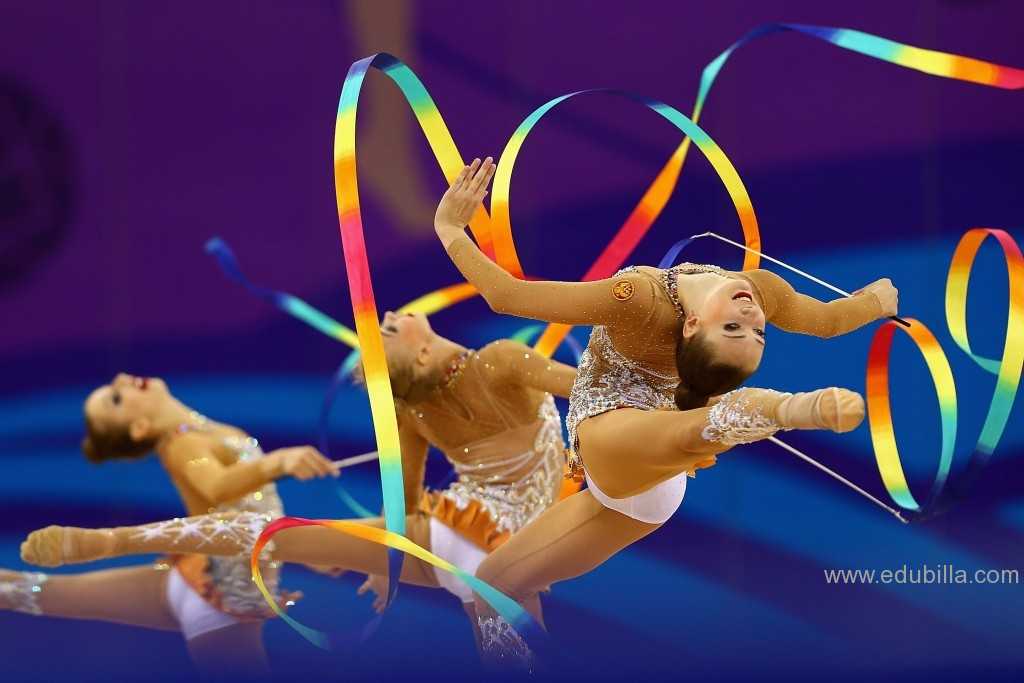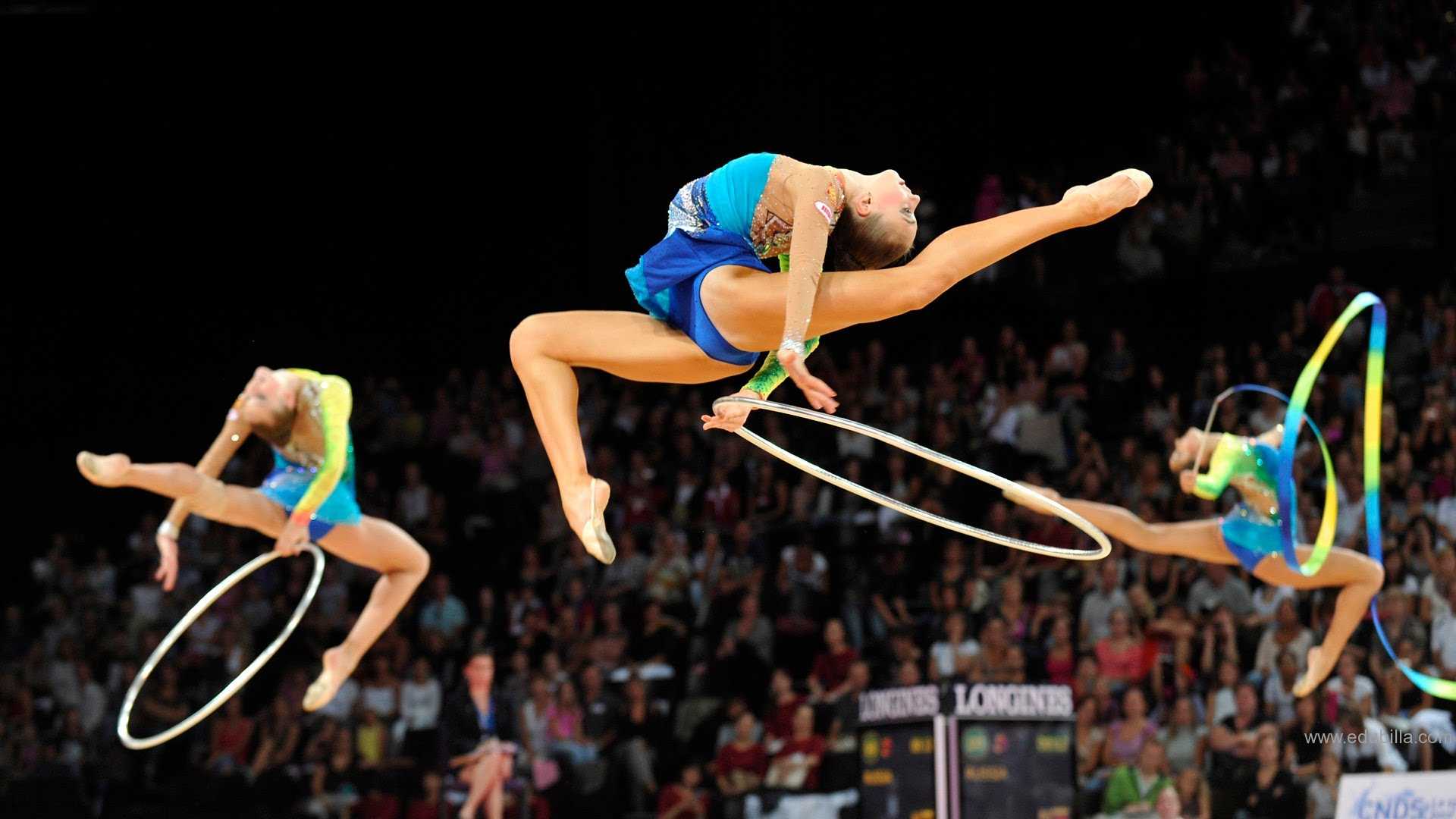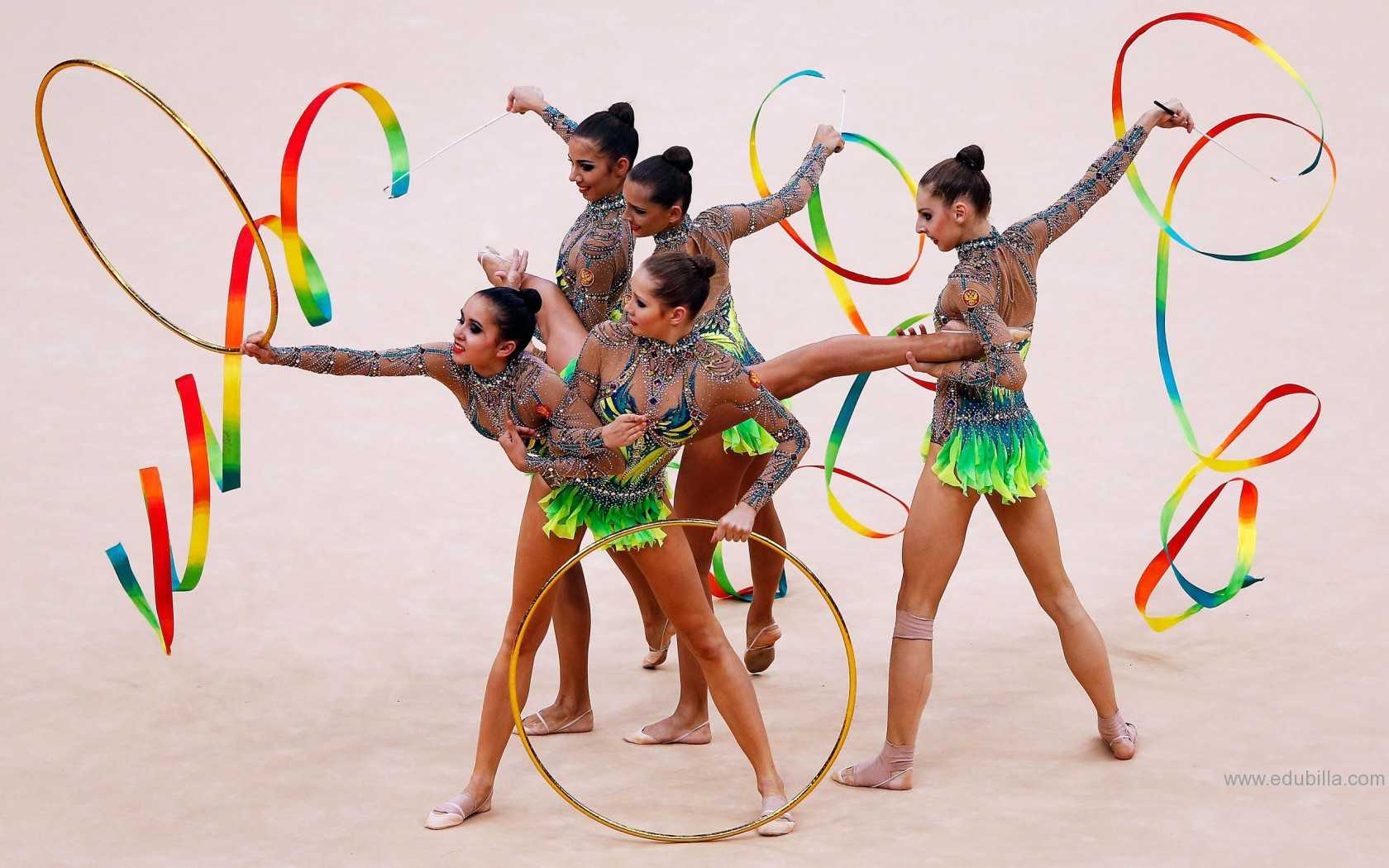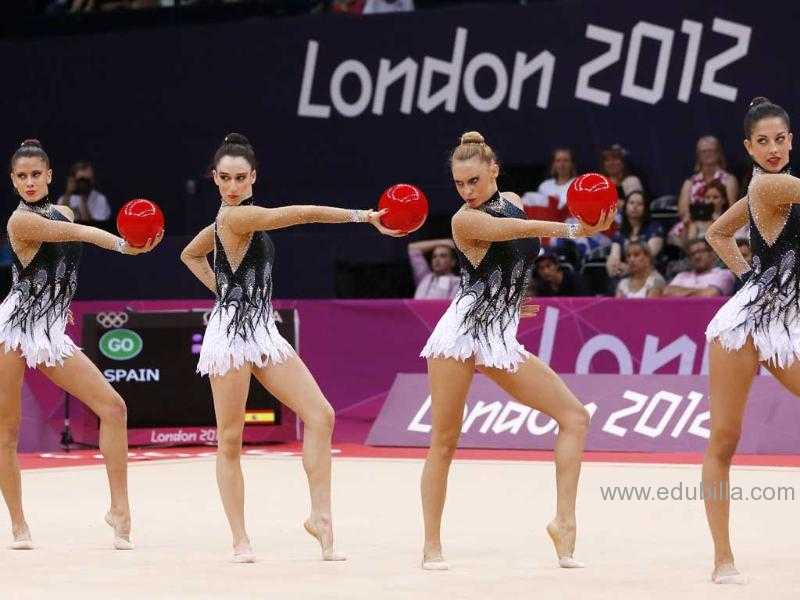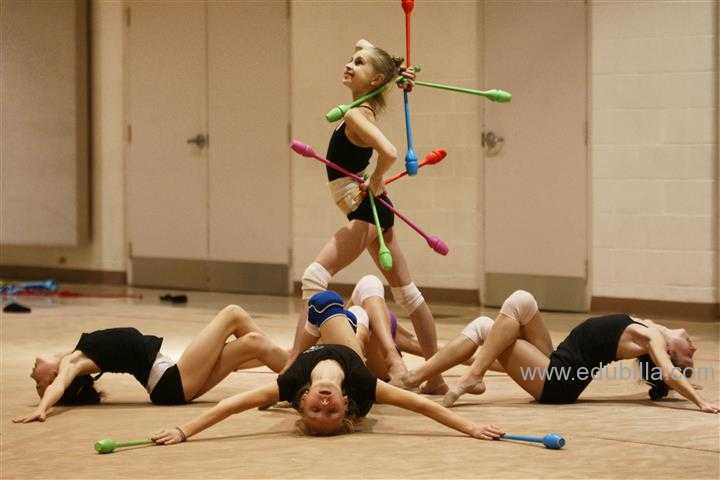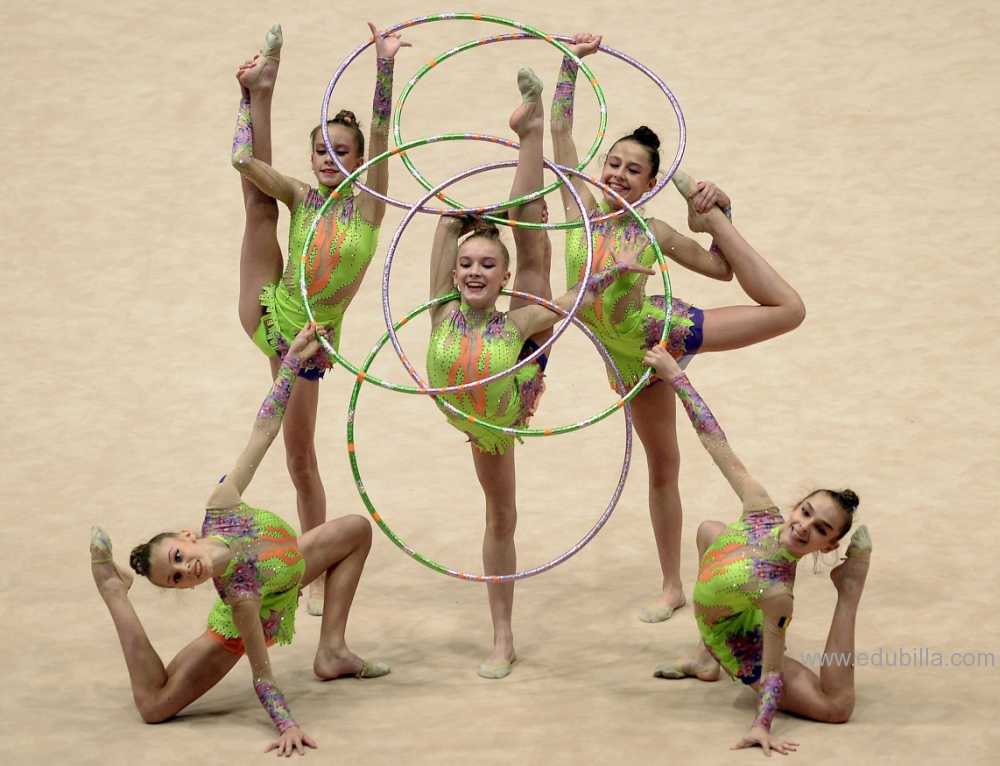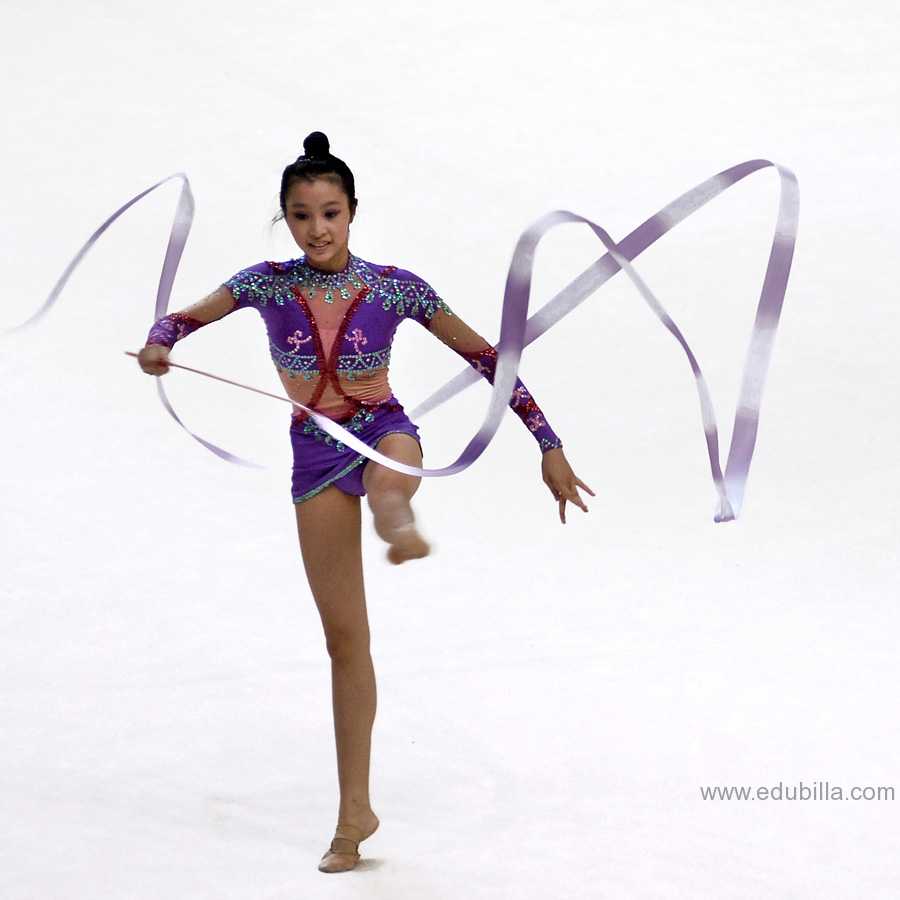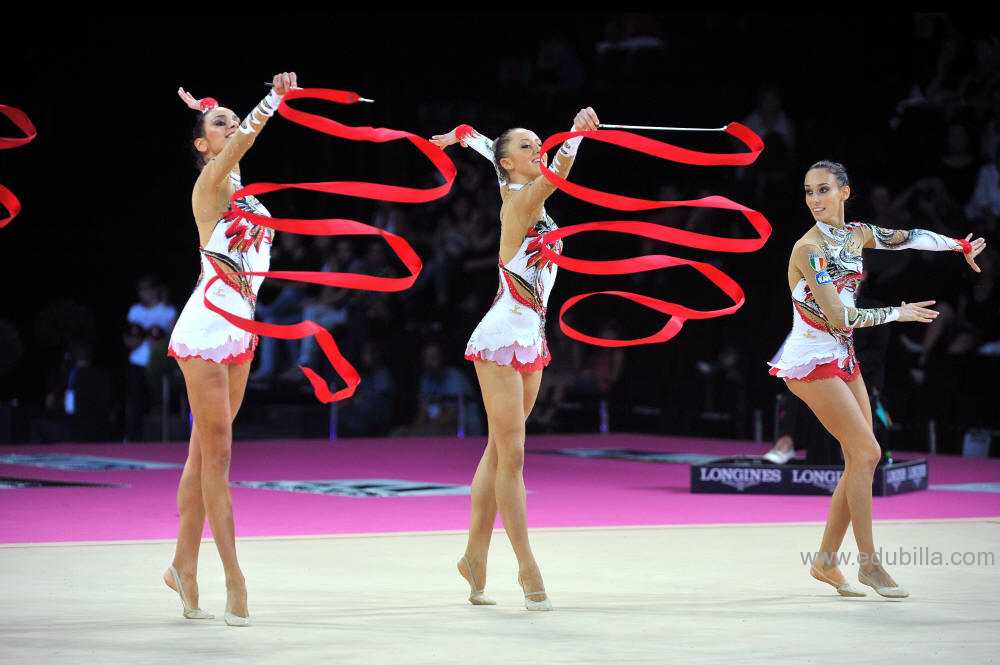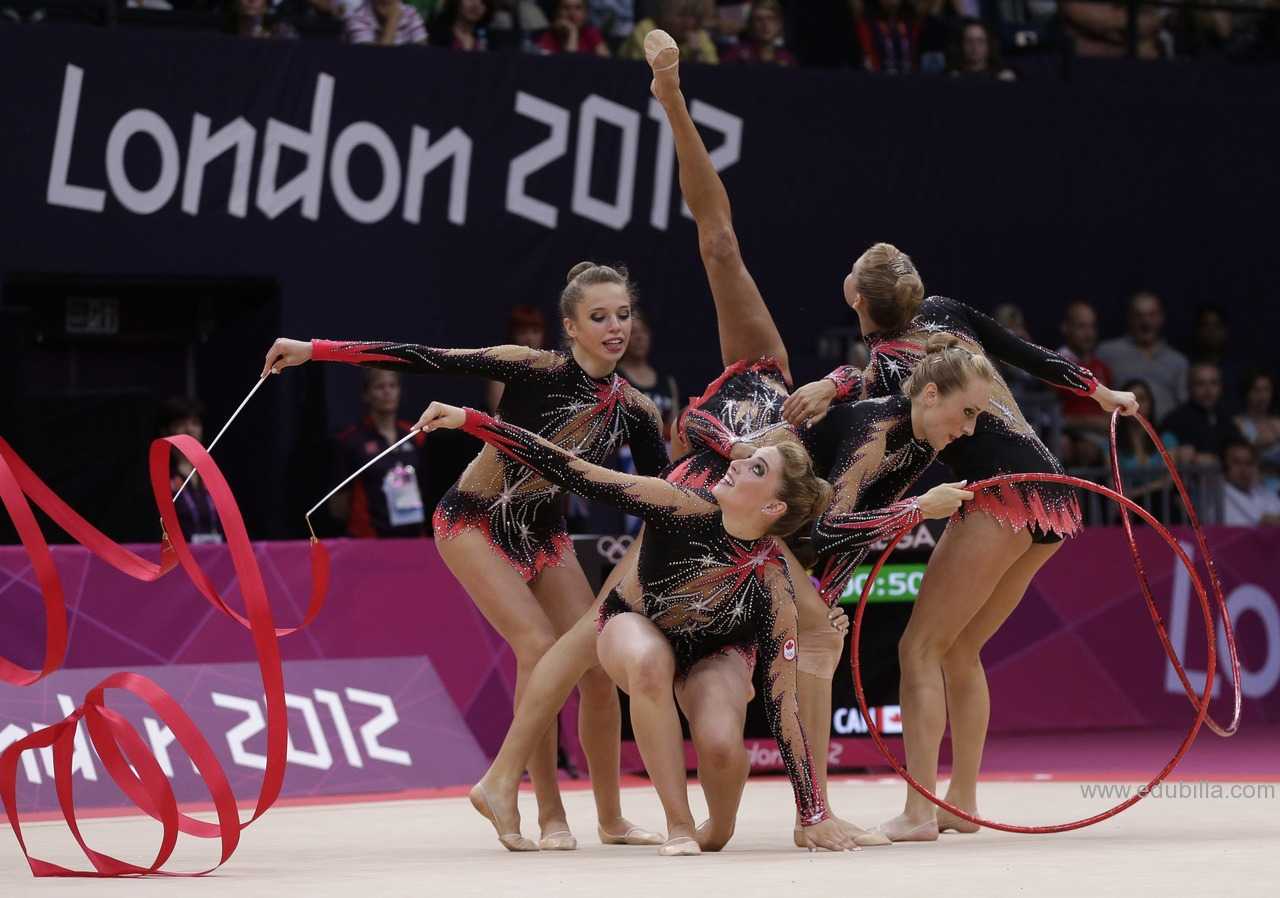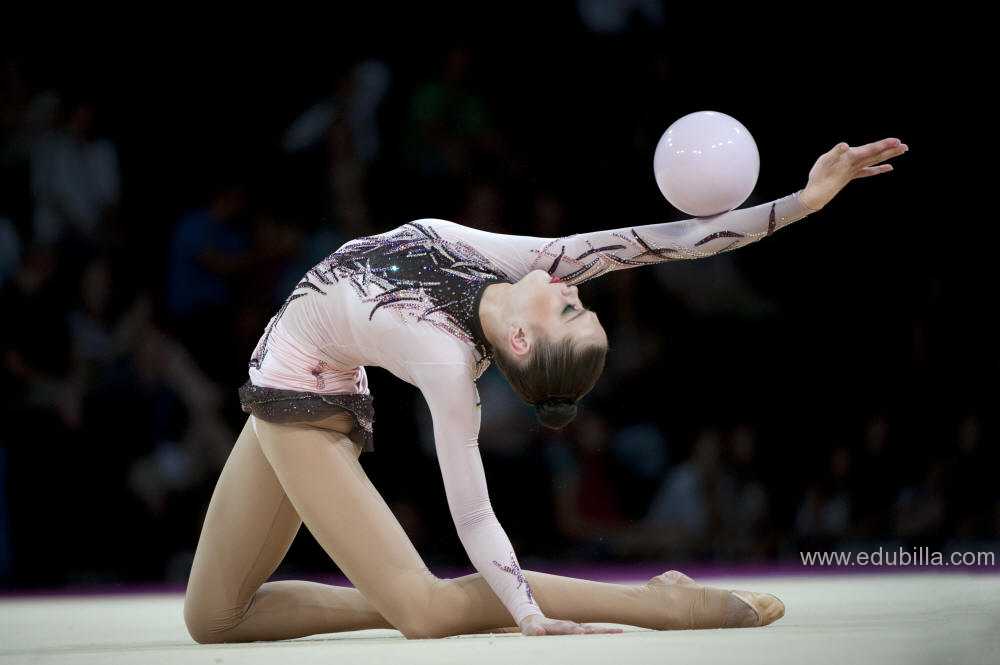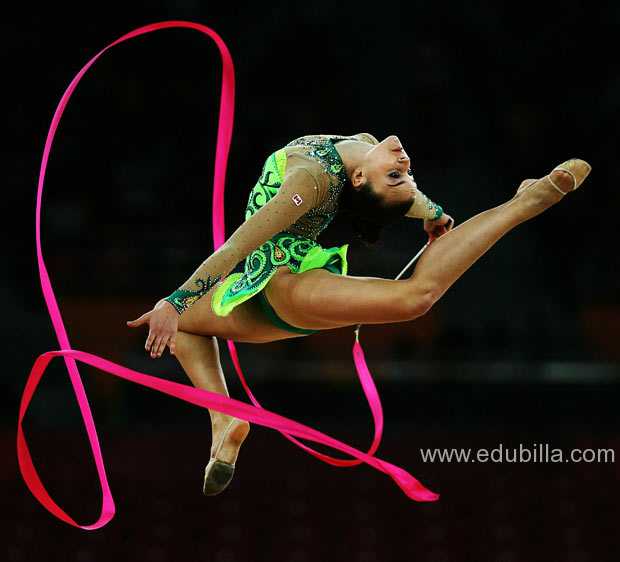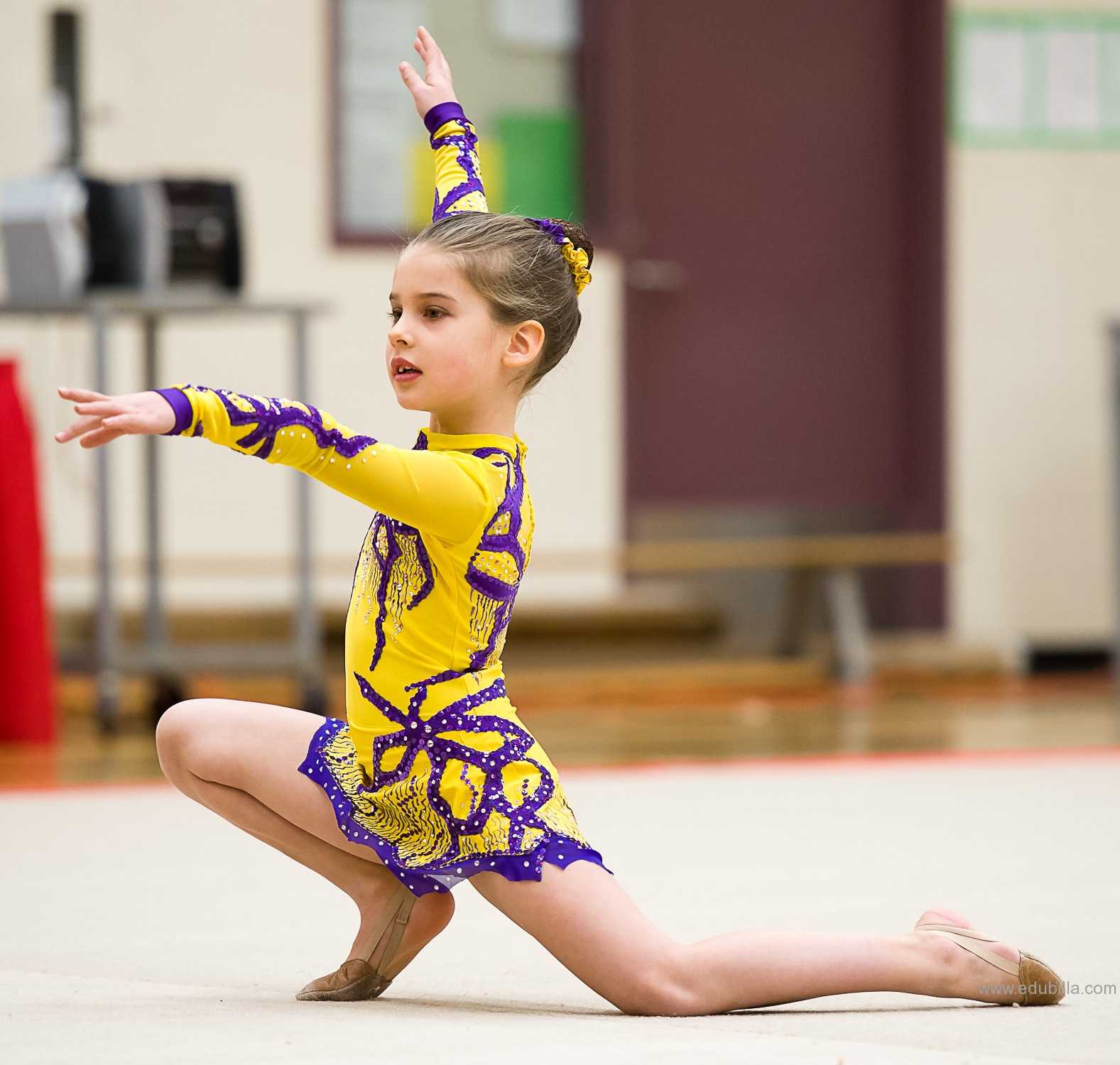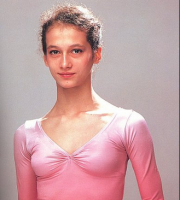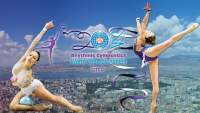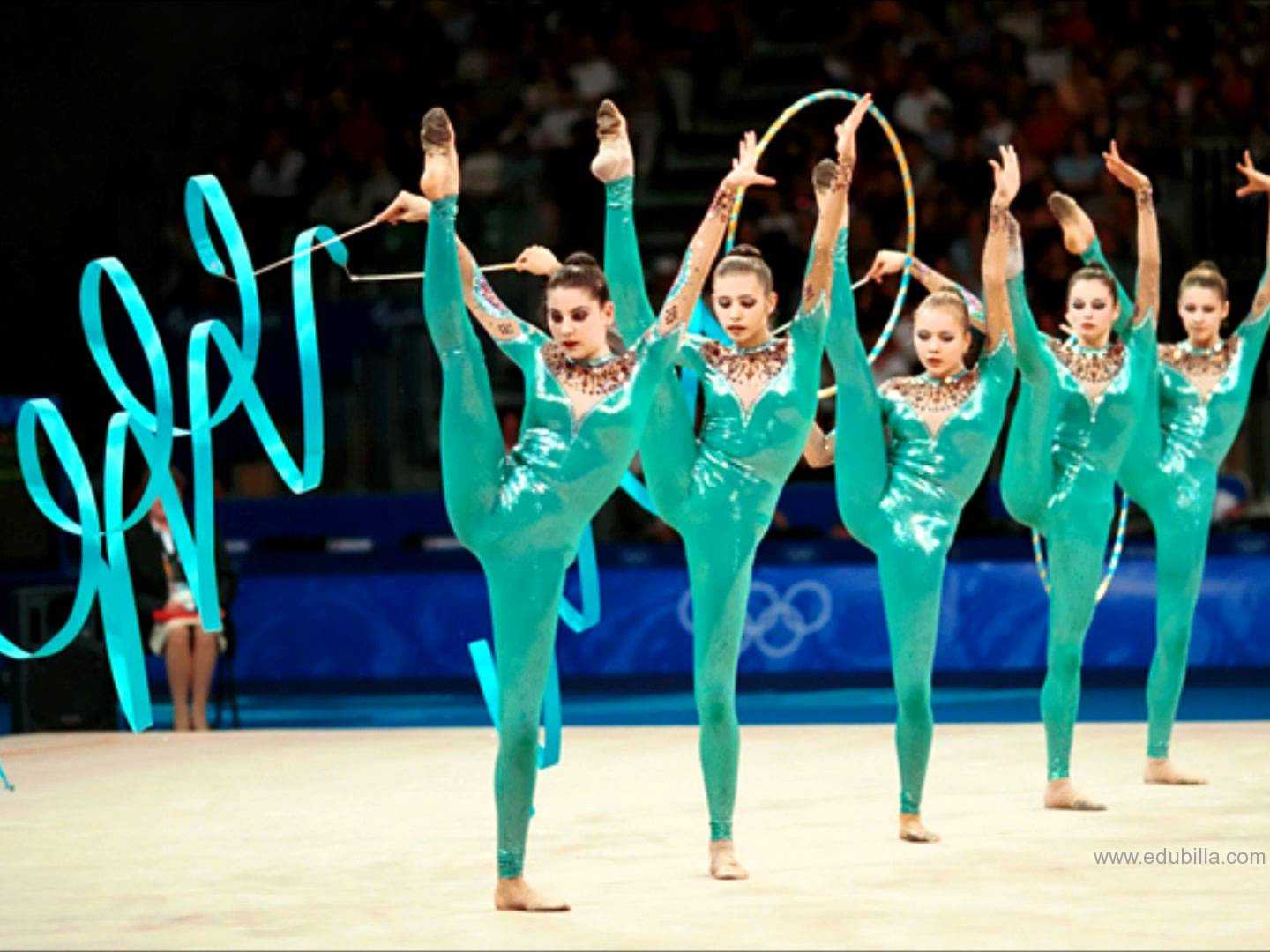
Overview Of Rhythmic Gymnastics
Rhythmic Gymnastics is a beautiful and elegant sport. Rhythmic Gymnastics routines containing many dance and ballet characteristics are performed to music using hand apparatus such as rope, ball, hoop, clubs and ribbon by individuals, pairs, trios or group of gymnasts.
Rhythmic gymnastics is a challenging and exiting activity for all children. Rhythmic Gymnastics focuses on body awareness and hand-eye coordination, team spirit, confidence building and problem solving.
Rhythmic Gymnastics provides children with the unique opportunity to express themselves to music, and the chance to compete at National and International level competitions.
Rhythmic gymnastics can be a very challenging sport. There are four main points to being a good gymnast.
1) Attitude : accepting criticism; not having a bad attitude, working hard, etc
2) Commitment : not giving up, trying to reach your goals, etc
3) Practice : Many people believe that this is the only thing needed to be a good gymnast, but this is not true.
4) Confidence : This is a key point.
The Participants:
- Olympic rhythmic gymnastics has only female participants. Girls start at a young age, and become age-eligible to compete in the Olympic Games and other major international competitions on January 1st of their 16th year. (For example, a gymnast born Dec. 31, 1996 was age eligible for the 2012 Olympics).
- In some countries, most notably Japan, males are beginning to participate in rhythmic gymnastics. In this hybrid form of gymnastics, the athletes also perform tumbling and martial arts skills
Apparatus:
The FIG selects which apparatus will be used in competitions; only four out of the five possible apparatuses are sanctioned. Up to 2010, the clubs were not used at the senior level. For 2011 rope will be dropped for senior national individual and group competition. In 2011, it will be dropped for junior national individual competition but return again in 2015. Rope appears in junior national group competition in 2011-2012.
- Floor
- Rope
- Hoop
- Ball
- Clubs
- Ribbon
General:
- Individual program consists of four (4) optional routines. The five apparatus are rope, hoop, ball, clubs and ribbon. Every two years one event in rotated out of the program. At early levels, there may be a floor routine.
- The group program consists of two routines. In the Junior Olympic program the groups perform a floor routine and an apparatus routine according to the apparatus rotation set by USA Gymnastics. Internationally the program consists of one routine with 5 of the same type of apparatus and one routine with two types of apparatus as set by the International Federation.
Individual Program:
- An individual routine consists of a maximum of 12 difficulties
- Each apparatus event has a special group of elements that are specific to that apparatus. Rope – Jumps/Leaps, Ball – Flexibilities, Clubs – Balances, Ribbon – Pivots, and Hoop is an equal distribution of all special groups.
- There must be a minimum of 6 special elements, which are named Compulsory Body Group Difficulties (GCOs) in each routine. And no more than 2 from each of the other groups which are called Non-compulsory Body Group Difficulties (non-GCOs).
- Each gymnast must complete a score form and submit to the judges prior to competition. No gymnast is allowed to compete without the form.
- The Junior Olympic Program (levels 3-8) is a development curriculum in the United States designed to prepare girls for the international program.
The Score:
Score is calculated with the following formula: (Difficulty score + Artistry score)/2 + Execution
Difficulty: This part of the score is made of the Compulsory and Non-Compulsory groups.
Execution: This part of the score includes all penalties or deductions based on “how well” the routine was performed. For example, amplitude, bent knees, pointed toes, wobbles, drops and much more. The exact deductions may be found in the FIG Code of Points.
Artistry: This part of the score is the Music and the Choreography of the routine.
Music:
- All routines must be performed with music, only short pauses are allowed.
- Music can be a single or many instruments as well as voice (without words).
- Noises like glass breaking, car engines, plane noises are not allowed
- The musical composition should have a guiding theme
- The musical themes must relate to each other and not have too many differences as to create a potpourri of music.
- Every gymnast must have their music on separate tapes or CDs
Choreography:
- The choreography must have a main idea that is developed from beginning to end using a variety of body movements and apparatus handlings.
- In every routine there should be a variety in the way the apparatus is used. In other words different tosses, catches and interesting movements.
- Also a variety in body movements and means of moving around the floor. The gymnast should not just walk around the floor. Dance is an important factor in the choreography.
- Every routine should have a balance of work with both the Right and Left hands.
- Acrobatic elements are limited to walkovers, cartwheels, rolls and movements that do not stop in the vertical position or show any flight.
- Mastery is the term given to the large tosses and catches of the apparatus.
- Originality elements are new and interesting work with the apparatus or with the connections between difficulties. All Originality elements are submitted to the International Federation for validation]
Balances:
- All balance difficulties must have a few basic qualities: must be performed on the toes or the knee, to be held clearly and have a good fixed shape. The balance must have amplitude and be coordinated with a minimum of two apparatus movements (Technical Movements).
- Balances performed on either a straight or bent knee doesn’t change the value of the balance
- During balances that rotate such as the Tour Lent, it is sufficient to just have the apparatus in motion throughout the balance.
Pivots:
- All pivot difficulties must have a few basic qualities: be performed on releve, have an exact shape from beginning to the end of the rotation and have good amplitude.
- The level of difficulty of the pivot is determined by the degrees of rotation.
- Pivots performed on bent or straight support leg doesn’t change the value of the pivot.
- The FIG Technical Committee doesn’t approve of pivots on the knee.
- All “ring’ shapes in pivot must have the foot in contact with the head
- During Penche pivots, the body must be held at horizontal throughout the entire pivot.
- As a rule, the pivot combinations must be performed entirely on toes without heel support.
Game Rules
- The Olympic athletes should be at least 16 years old at the end of Olympic Year
- There are two events in the Olympic Competition Individual All-Around in which the athlete performs on the floor with a hoop, ball, clubs, or ribbon. The second event is the Group All-Around in which a total of 5 gymnasts compete in two sets of rounds
- The standard measurement of the floor area is 13m by 13m
- The permitted time for any individual exercise is between 1 minute 15 seconds and 1 minute 30 seconds and 2 minute 15 seconds to 2 minutes 30 seconds for group exercise
- The highest score is fixed at 20.0 for each of the events and it is judged on the execution of the stunt and choreography
- The Execution Score or E is scored out of 10.0 and points are deducted for technical faults like incorrect catch of the apparatus or losing the apparatus
- The Artistic Score or A has a maximum of 10.0 and is marked for the music and choreography
- The Difficulty Score or D begins at 0 and is scored to a maximum of 10.0 points
- For the Final Composition Scoring, Artistic Score and Difficulty Score is added and an average is taken. (A+D divided by 2)
Equipments Need For Rhythmic Gymnastics
Ball:
The ball must be made of rubber or soft plastic, with a diameter of 18-20cm. It must weigh at least 400g.
Hoop:
The hoop may be made of wood or plastic, with an inner diameter of 80 to 90 centimetres. It must weigh at least 300 grams. Performances must include at least three leaps.
Rope:
The rope, made from hemp or a similar material, has no set length because it is relative to the height of the gymnast. Performances must include at least three leaps.
Clubs:
Gymnasts work with two bottle-shaped clubs of equal length, 40-50cm, and resembling a slender tenpin bowling pin in shape. Made of wood or plastic and weighing at least 150g, the clubs have a wide end (the body), a tapering middle section (the neck), and usually a ball on the end (the head) with a maximum diameter of 30mm.
Plane:
An imaginary surface where moves are performed, i.e. lateral, frontal, horizontal or diagonal.
Diagonal plane:
An imaginary surface, at less than a 90-degree angle to the floor, where moves are performed.
Horizontal plane:
An imaginary surface, level with the ground, where moves are performed.
Lateral plane:
An imaginary surface to the side of and parallel to the body, where moves are performed.
Ribbon:
The ribbon is a single 7m strip of ribbon made from satin or a similar material. One metre of its length is folded and doubled so it may be attached by a cord to a cylindrical stick 50-60cm in length which the gymnast grasps. The ribbon must stay in perpetual, fluid motion throughout the routine.
History Of Rhythmic Gymnastics
In rhythmic gymnastics the athletes perform with equipment instead of on equipment. Gymnasts perform jumps, tosses, leaps and other moves with different types of apparatus, and are judged much more on their grace, dance ability, and coordination than their power or tumbling prowess.
History of Rhythmic Gymnastics:
Rhythmic gymnastics is an Olympic sport that combines ballet, dance, and acrobatics, with expressive movement and apparatus manipulation of the ball, clubs, hoop, ribbon, and rope. This sport is perfectly balanced for developing flexibility, strength, and hand/body-eye coordination. It has been used for years in Europe as part of the physical education regime in schools.
The sport of rhythmic gymnastics grew out of many styles of dance and exercise regimes that shared the common idea of expressive movement as a tool for exercise.
Timeline
Early 1900s: The Swedish School of Rhythmic Gymnastics began the first rhythmic program.
1940:The first competitive rhythmic program was developed in the Soviet Union.
1945:In Canada, a Czech Club, 'Sokol', had rythmics on its program.
1948:Man's Rhythmic Gymnastics was originated from Japan. Japan Gymnastics Association contains both Artisic Gymnastics and Rhythmic Gymnastics. The Rhythmic Gymnastics organization consists of man and woman as separate discipline. Man's Rhythmic Gymnastics was formally organized in 1948 by Professor Kiichiro Toyama. Man's RG uses 4 apparatus - staff, double ring, clubs and rope. Group routines consist of 6 persons. Competition levels include junior-high, high school, university and nationals.
1946:the Japan Gymnastic Association was established and group floor exercises were performed for the first time at the National sports Festival in 1949.
1949:In 1949 came a Finnish Club, 'Sinikat' and also 'Helen Tiidus' Girls'. Since these are all ethnic oriented clubs, RG was kept a 'secret' from other Canadians for still quite some time.
1950:Rhythmic gymnastics enters the curriculum of the Bulgaria National Sport Academy in 1950 (High School for Physical Education then).
1958:Questo was established in 1958 by Hilja Paul in Quebec Canada. Her daughter, Siiri Paul continues her footsteps as both coach and judge.1963:The first world championship was held in Budapest, Hungary.
1960:Evelyn Koops, graduate of the Ernest Idla Institute from Sweden, began taking teams from her Kalev-Estienne Club on tours of Canada and the US, giving exhibitions and conducting clinics. Mrs Koops drive and passion for the sport made an impact to the early acceptance of the sport in North America.
1961:The first international competition was held between the Soviet, Bulgarian and Czechoslovakian delegations. That year the Soviets and Bulgarians dominated the competition and have continued to occupy the top spots internationally,Rhythmic gymnastics first appeared in the programme of the 1961 Summer Universiade in Sofia, Bulgaria.
1962:After World War II, scoring methods, based partly on Ernest Idla's degree of difficulty tables, were developed in Europe to create the competitive form of rhythmic gymnastics, which was recognized as a sport by the International Gymnastics Federation (FIG) in 1962.
1964:At the Olympic Games in Tokyo, JPN, KOR, CHN and PHI proposed call the meeting and discussed and approved gymnastics to be official event at the Asian Games. And at same time ASIAN GYMNASTIC FEDERATION (AGF) was started.
1967:The group exercise was introduced in Copenhagen, Denmark. The group exercise involved all the components of rhythmic, but also added the challenge of synchronizing movements and tosses between three to five girls on the floor.
1970:On June 19th, 1970, the first Canadian National Championship was held in Toronto.1984:Rhythmic was finally introduced into the Olympic Games, which were hosted by Los Angeles, CA. This was the year that many Eastern European countries were forced to boycott the Olympics. Canadian Lori Fung took home the first gold.
1971:The first time Canada participated in Worlds (Cuba) with Evelyn Koop as coach of the Kalev Senior group, which placed 8th out of 15 countries. Individual gymnasts, also from Kalev, were Susanne Mihkelson, Connie Lindenberger and Melanie Ivey.
1973 :At the World Championship, the clubs were compulsory and hoop, ball and ribbon were freestyle. This is the start of the custom to select four out of five apparatus.
1996:Group event was added to the Olympics.
1997 :This was the first time that World Championship results were posted on the internet as the athletes were still competing. Alex Kochann was the facilitor of this undertaking in Berlin.
1998:This was the first World Championship dedicated to just group routines in Sevilla, Spain. The plan was to have alternate years between individuals and groups and to have a combined meet in the year before the Olympics.
1999:Nadejda Jastrjembskaia published a Rhythmic Gymnastics book that was intended for the competitive gymnasts/coaches.
2000:The first AGG Worlds were held in Helsinki in 2000, where teams from Kalev (coach Evelyn Koop), Ritmika (coach Anneli Riga) and Rhythmic Waves (coach Marta Selmeczi) participated. Canadian judge was Maija Ceming from the Sampo club.
First Rhythmic Gymnastics world championship:
Rhythmic gymnastics started as an independent competitive sport in the early nineteen fifties by the Russians. Then in nineteen sixty three the first rhythmic gymnastics world championship was held in Europe. Even though rhythmic gymnastics has its own world championships it did not become an Olympic medal sport until nineteen eighty four. This is partly why rhythmics is such a little known and hardly recognized sport in the U.S.
Rhythmic Gymnastics in Australia:
Rhythmic Gymnastics in Australia has a national system of Levels which provides an opportunity for gymnasts of different levels and ability to enjoy the sport. Young gymnasts start from Level 0 and can grow up to Level 10. Older gymnasts can also enter Rhythmic Gymnastics, their ability will be assessed and they can start to do a more advanced level than young gymnasts.
Worldwide popularity :
Rhythmic gymnastics is a global sport and is extremely popular in many countries. In many countries rhythmic gymnastics is even more popular than women?s artistic gymnastics.
Below are the countries where rhythmic gymnastics is very popular and which successfully compete on international level: North and South America: Canada, United States, Argentina and Brazil. Europe: France, Italy, Greece, Bulgaria countries of former Yugoslavia, Germany, England, Spain, Russia, Ukraine, Belarus, Poland, Netherlands, Turkey, Israel, Georgia, Switzerland, Austria, Hungry, Moldova, Lithuania Asia: Japan, Malaysia, China Central Asia: Uzbekistan, Kazakhstan Oceania: Australia, New Zealand. Africa: South Africa and Egypt
Men' Rhythmic Gymnastics:
While Rhythmic gymnastics is perceived to be only female sport there is strong development in creating oficial rhythmic gymnastics for men. Men's rhythmic gymnastics involves tumpling and performed on a spring floor. Apparatus includes: rope, stick, double rings and clubs. In group routines gymnasts don't use any apparatus. The following countries participate in man's rhythmic gymnastics: Japan, Malaysia, Korea, Canada and United States.
Origin Of Rhythmic Gymnastics
Rhythmic gymnastics is a women-only event in which gymnasts perform on a floor with a rope, hoop, ball, clubs or ribbon accompanied by music, in individual or group events.
Faster and stronger:
In the 1800s rhythmic gymnastics operated under the guise of group gymnastics, and included a trace of elementary choreography. It grew slowly until the first experimental competitions appeared in eastern Europe in the 1930s, when its newfound complexity began to draw a wider audience.
Many parents:
Rhythmic gymnastics evolved from a host of related disciplines. It incorporates elements from classical ballet, such as pliés and arabesques, as well as the German system of emphasising apparatus work for muscle development and the Swedish method of using free exercise to develop rhythm.
First tournament:
The FIG recognised rhythmic gymnastics as an official discipline in 1963, and a year later organised an international tournament in Budapest. In 1964 the tournament was officially declared the first Rhythmic Gymnastics World Championships, and Ludmila Savinkova of the Soviet Union became the first world champion.
World sport:
The number of athletes grew as interest spread to other parts of the world. Gymnasts from the United States first appeared at the championships in 1973, and rhythmic gymnastics slowly emerged from the shadow of the long-established artistic discipline to enter the Olympic programme in 1984.
Olympic history:
Since its integration into the Games in 1984 in Los Angeles, rhythmic gymnastics has always been a part of the Olympic programme. In its inaugural year, it was Canada’s Lori Fung who won the gold medal.
Until 1992 in Barcelona, only one individual event was on the programme. A second, team event was added to the programme in 1996 in Atlanta.
At the 2000 Games in Sydney, the Russian Federation won two gold medals: the group and individual multiple competitions.
Governing Bodies
International Federation of Gymnastics(FIG):
The Fédération Internationale de Gymnastique (FIG) or International Federation of Gymnastics (IFG) is the governing body of competitive gymnastics. Its headquarters is in Lausanne, Switzerland. It was founded on July 23, 1881 in Liège, Belgium, making it the worlds oldest existing international sport organisation.Originally called the European Federation of Gymnastics, it had three member countries – Belgium, France and the Netherlands – until 1921, when non-European countries were admitted, and it was renamed to its current name.
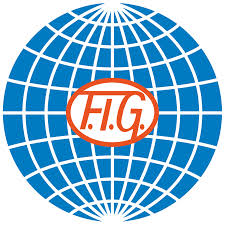
The Origins:
The idea to set up a Solidarity Foundation for gymnasts dates back to 1999-2000. At the time, FIG President Bruno Grandi was also chairing the Italian Federation, which had a similar system designed to help gymnasts who were reaching the end of their careers.
In Switzerland, the "Hans Schachenmann" Foundation was created in 1962 by a generous donor in favour of gymnasts who had been victims of illness or accidents. President Grandi and then-Secretary General Norbert Bueche used this model to draw up a similar project for the FIG. Their project was submitted to and approved by the FIG Executive Committee.
At the 2000 FIG Congress in Marrakech (MAR), it was decided that the sum of CHF 2,000,000.— would be transferred from the FIG assets to the Foundation to set up the equity capital. A second instalment of CHF 1,000,000.— was then paid by FIG to the Foundation in 2012. The Foundation Deed was signed on June 7, 2002.
The Aims:
The aims of the Foundation are provided for under Art. 2 of the Foundation Deed. In short:
- to promote assistance and solidarity towards gymnasts who are victims of illness or accidents ;
- to support scientific research aiming at preserving gymnasts’ health ;
- to help developing countries promote gymnastics ;
- to provide gymnastics apparatus to countries in difficult situations.
Aid is provided through equity capital interest only.
The Achievements:
The Foundation mainly provides some aid to gymnasts who have been victims of accidents at gymnastics competitions or during training sessions. Unfortunately, serious accidents, such as falls resulting in paralysis, have occurred. Cases have been reported from all continents. To date, 15 gymnasts have been financially helped by the Foundation.
Several developing Federations have been supplied with apparatus or floors.
The Foundation Board is also in charge of scholarships allocated to promising young gymnasts in all Olympic disciplines and on all continents. The IOC’s annual subsidy is included in this management.
Awards Related To Rhythmic Gymnastics
David Nixon Award:
David Dixon Award is a four-yearly award given to the outstanding athlete of each Commonwealth Games, based on their performance at the event, fair play, and overall contribution to their team's participation at the Commonwealth Games.
The award was introduced in the 2002 Commonwealth Games in Manchester and is named after the former honorary secretary of the Commonwealth Games Federation for 17 years, David Dixon
USA Gymnastics awards:
Coach of the Year
Judge of the Year
Large Team Compulsory Coaching Staff of the Year
Small Team Compulsory Coaching Staff of the Year
Coaching Staff of the Year
Sample Documents Of Rhythmic Gymnastics
-Muhammad Ali


